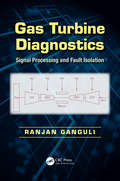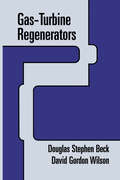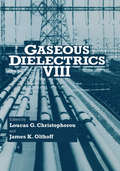- Table View
- List View
Gas Turbine Design, Components and System Design Integration: Second Revised and Enhanced Edition
by Meinhard T. SchobeiriThis is the second revised and enhanced edition of the book Gas Turbine Design, Components and System Integration written by a world-renowned expert with more than forty years of active gas turbine R&D experience. It comprehensively treats the design of gas turbine components and their integration into a complete system. Unlike many currently available gas turbine handbooks that provide the reader with an overview without in-depth treatment of the subject, the current book is concentrated on a detailed aero-thermodynamics, design and off-deign performance aspects of individual components as well as the system integration and its dynamic operation. This new book provides practicing gas turbine designers and young engineers working in the industry with design material that the manufacturers would keep proprietary. The book is also intended to provide instructors of turbomachinery courses around the world with a powerful tool to assign gas turbine components as project and individual modules that are integrated into a complete system. Quoting many statements by the gas turbine industry professionals, the young engineers graduated from the turbomachinery courses offered by the author, had the competency of engineers equivalent to three to four years of industrial experience.
Gas Turbine Diagnostics: Signal Processing and Fault Isolation
by Ranjan GanguliWidely used for power generation, gas turbine engines are susceptible to faults due to the harsh working environment. Most engine problems are preceded by a sharp change in measurement deviations compared to a baseline engine, but the trend data of these deviations over time are contaminated with noise and non-Gaussian outliers. Gas Turbine Diagnos
Gas Turbine Handbook: Principles and Practice, Fifth Edition
by Tony GiampaoloNewly revised, this new fifth edition includes a chapter on waste heat recovery and discusses this technology in detail including a the advantages and barriers to waste heat recovery, environmental restraints, thermodynamics of heat recovery, fluid properties, boiler, condensers, steam turbines, off design behavior and exhaust catalyst. This book shows how microturbine designs rely heavily on the centrifugal compressor and are, in many aspects, similar to the early flight engines and will illustrate how the approach of the microturbine designer is to minimize cost.
Gas Turbine Parameter Corrections (Elements In Aerospace Engineering Ser.)
by Allan J. VolponiThe volume provides an exhaustive catalog of common standard day corrections for gas turbine gas path parameters, explores their history, and, most importantly, provides a mathematical framework for the derivation of these important normalization factors. Although use of these corrections is common practice within industry, government, and academia, their genesis, and, in particular, how they can be derived from simple principles, is not general knowledge among many of those who use them on a regular basis. This book elucidates calculation of these important coefficients. Standing as a one-stop source on derivations and a methodology for additional parameter correction refinements, Gas Turbine Parameter Corrections, is ideal as a desk reference for practitioners and researchers, as well as supplemental instruction for university courses on gas turbine performance, control, and DPHM (diagnostics, prognostics and health management).
Gas Turbine Performance
by Philip P. Walsh Paul FletcherA significant addition to the literature on gas turbine technology, the second edition of Gas Turbine Performance is a lengthy text covering product advances and technological developments. Including extensive figures, charts, tables and formulae, this book will interest everyone concerned with gas turbine technology, whether they are designers, marketing staff or users.
Gas-Turbine Regenerators
by Douglas Beck David G. WilsonRegenerative gas turbines are attractive alternatives to diesel engines and spark ignition engines for automobiles and to diesel engines and combined-cycle en gines for power generation. Theory indicates regenerative gas turbines should achieve higher thermal efficiencies than those of diesel engines and combined cycle engines. Further, regenerative gas turbines are potentially lower in cost, require less maintenance, require less space, and pollute less than competitive systems. Regenerators can be used for exhaust-gas heat exchange or for intercooling in gas-turbine systems. As an exhaust-gas heat exchanger, a regenerator recovers heat from the exhaust and uses it to preheat the compressed air before the compressed air enters the combustor. Preheating of the compressed air permits a small heat input to the combustor for a given power output of the engine. As an intercooler, a regenerator cools the gas between compressor stages. Less work is required to compress cool gas than is required to compress warm gas. Therefore, a regenerator intercooler can reduce the required work input to the compressor. Thus, regenerators can be used to increase the thermal efficiencies and power outputs of gas turbines. the backbones of high-performance re High-performance regenerators are generative gas turbines. In the past, lack of understanding of regenerator per formance has led to sub-optimal engine designs. Now this book gives com prehensive regenerator information. With this book, the designer can design regenerators that will yield gas turbines with maximum thermal efficiencies.
Gas Turbines Modeling, Simulation, and Control: Using Artificial Neural Networks
by Hamid AsgariGas Turbines Modeling, Simulation, and Control: Using Artificial Neural Networks provides new approaches and novel solutions to the modeling, simulation, and control of gas turbines (GTs) using artificial neural networks (ANNs). After delivering a brief introduction to GT performance and classification, the book:Outlines important criteria to consi
Gas Turbines Modeling, Simulation, and Control: Using Artificial Neural Networks
by Hamid Asgari XiaoQi ChenGas Turbines Modeling, Simulation, and Control: Using Artificial Neural Networks provides new approaches and novel solutions to the modeling, simulation, and control of gas turbines (GTs) using artificial neural networks (ANNs). After delivering a brief introduction to GT performance and classification, the book:Outlines important criteria to consi
Gas Turbines Structural Properties, Operation Principles and Design Features
by Kun Liu Daifen Chen Serhiy Serbin Volodymyr PatlaichukThe book gives a clear idea about the concept of gas turbines, thermodynamic basics of the turbine theory. It includes classification of gas turbines, working principle, structure feather, application and designing approaches of gas turbines. The readers will understand easily the power system for ships since there are a lot illustrations and instruction for each of equipment. It also introduces the thermal calculation of gas turbine unit, different structure feather of compressor, combustion chamber and turbine. It gives the way to increases the efficiency of the unit, design and operation of the gas turbine parts. The combined marine power plant with gas turbine is discussed and advantages and disadvantages for each type unit is discussed too.
Gas- und magnetofluiddynamische Maßnahmen zur Beeinflussung der Nahtqualität beim Laserstrahlschweißen (Laser in der Materialbearbeitung)
by Markus KernGaseous and Electrochemical Hydrogen Storage Properties of Mg-Based Thin Films (Springer Theses)
by Gongbiao XinThis thesis introduces the preparation of a series of Mg-based thin films with different structures using magnetron sputtering, as well as the systematical investigation of their gaseous and electrochemical hydrogen storage properties under mild conditions. It reviews promising applications of Mg-based thin films in smart windows, hydrogen sensors and Ni-MH batteries, while also providing significant insights into research conducted on Mg-based hydrogen storage materials, especially the Mg-based films. Moreover, the unique experimental procedures and methods (including electric resistance, optical transmittance and electrochemical methods) used in this thesis will serve as a valuable reference for researchers in the field of Mg-based hydrogen storage films.
Gaseous Detonation Physics and Its Universal Framework Theory (Shock Wave and High Pressure Phenomena)
by Zonglin Jiang Honghui TengThis book highlights the theories and research progress in gaseous detonation research, and proposes a universal framework theory that overcomes the current research limitations. Gaseous detonation is an extremely fast type of combustion that propagates at supersonic speed in premixed combustible gas. Being self-sustaining and self-organizing with the unique nature of pressure gaining, gaseous detonation and its gas dynamics has been an interdisciplinary frontier for decades. The research of detonation enjoyed its early success from the development of the CJ theory and ZND modeling, but phenomenon is far from being understood quantitatively, and the development of theories to predict the three-dimensional cellular structure remains a formidable task, being essentially a problem in high-speed compressible reacting flow. This theory proposed by the authors’ research group breaks down the limitation of the one-dimensional steady flow hypothesis of the early theories, successfully correlating the propagation and initiation processes of gaseous detonation, and realizing the unified expression of the three-dimensional structure of cell detonation. The book and the proposed open framework is of high value for researchers in conventional applications such as coal mine explosions and chemical plant accidents, and state-of-the-art research fields such as supernova explosion, new aerospace propulsion engines, and detonation-driven hypersonic testing facilities. It is also a driving force for future research of detonation.
Gaseous Dielectrics IX
by Loucas G. Christophorou James K. OlthoffGaseous Dielectrics IX covers recent advances and developments in a wide range of basic, applied, and industrial areas of gaseous dielectrics.
Gaseous Dielectrics VI
by Loucas G. Christophorou Isidor SauersThe Sixth International Symposium on Gaseous Dielectrics was held in Knoxville, Tennessee, U.S.A., on September 23-27, 1990. The symposium continued the trans disciplinary character and comprehensive approach of the preceding five symposia. Gaseous Dielectrics VI is a detailed record of the symposium proceedings. It covers recent advances and developments in a wide range of basic, applied and industrial areas of gaseous dielectrics. It is hoped that Gaseous Dielectrics VI will aid future research and development in and encourage wider industrial use of gaseous dielectrics. The Organizing Committee of the Sixth International Symposium on Gaseous Dielectrics consisted of L. G. Christophorou (U.S.A.), F. Y. Chu (Canada), A. H. Cookson (U.S.A.), D. L. Damsky (U.S.A.), O. Farish (U.K.), I. Gallimberti (Italy), A. Garscadden (U.S.A.), E. Marode (France), T. Nitta (Japan), W. Pfeiffer (Germany), I. Sauers (U.S.A.), R. J. Van Brunt (U.S.A.), and W. Zaengl (Switzerland). The local arrangements committee consisted of members of the Health and Safety Research Division and personnel of the Conference Office of the Oak Ridge National Laboratory, and staff of the University of Tennessee (UTK). The contributions of each member of these committees, the work of the Session Chairmen, the interest of the participants, and the advice of innumerable colleagues are gratefully acknowledged.
Gaseous Dielectrics VII
by Loucas G. Christophorou D. R. JamesThe Seventh International Symposium on Gaseous Dielectrics was held in Knoxville, Tennessee, U. S. A. , on April 24-28, 1994. The symposium continued the interdisciplinary character and comprehensive approach of the preceding six symposia. Gaseous DielecIries VII is a detailed record of the symposium proceedings. It covers recent advances and developments in a wide range of basic, applied and industrial areas of gaseous dielectrics. It is hoped that Gaseous DielecIries VII will aid future research and development in, and encourage wider industrial use of, gaseous dielectrics. The Organizing Committee of the Seventh International Symposium on Gaseous Dielectrics consisted of G. Addis (U. S. A. ), L. G. Christophorou (U. S. A. ), F. Y. Chu (Canada), A. H. Cookson (U. S. A. ), O. Farish (U. K. ), I. Gallimberti (Italy) , A. Garscadden (U. S. A. ), D. R. James (U. S. A. ), E. Marode (France), T. Nitta (Japan), W. Pfeiffer (Germany), Y. Qiu (China), I. Sauers (U. S. A. ), R. J. Van Brunt (U. S. A. ), and W. Zaengl (Switzerland). The local arrangements committee consisted of members of the Health Sciences Research Division and personnel of the Conference Office of the Oak Ridge National Laboratory, and staff of the University of Tennessee (UTK). The contributions of each member of these committees, the work of the Session Chairmen, the interest of the participants, and the advice of innumerable colleagues are gratefully acknowledged. I am especially indebted to Dr. Isidor Sauers, Dr. David R. James, Mrs.
Gaseous Dielectrics VIII
by Loucas G. Christophorou James K. OlthoffGaseous Dielectrics VIII covers recent advances and developments in a wide range of basic, applied, and industrial areas of gaseous dielectrics.
Gaseous Electronics: Tables, Atoms, and Molecules
by Gorur Govinda RajuWith the constant emergence of new research and application possibilities, gaseous electronics is more important than ever in disciplines including engineering (electrical, power, mechanical, electronics, and environmental), physics, and electronics. The first resource of its kind, Gaseous Electronics: Tables, Atoms, and Molecules fulfills the author’s vision of a stand-alone reference to condense 100 years of research on electron-neutral collision data into one easily searchable volume. It presents most—if not all—of the properly classified experimental results that scientists, researchers, and students require for a theoretical and practical understanding of collision properties and their impact. An unprecedented collection and analysis of electron neutral collision properties This book follows a new user-friendly format that enables readers to easily retrieve, analyze, and apply specific atomic/molecular information as needed. In his previous work, Gaseous Electronics: Theory and Practice, the author first explored electron–neutron interactions. To clarify the complex fundamental processes involved, he cited as much experimental data on atoms and molecules as limited space would allow. Completing that task, this handy reference more fully compiles essential revised data on more than 420 atoms and molecules, arranging it into easily digestible chapters, sections, and appendices. Analysis parameters include total scattering, ionization, excitation, attachment cross sections, ionization and attachment coefficients, attachment rates, and ion drift velocity. Some recent research areas in gaseous electronics include: Environmentally efficient and protective lighting devices Plasma research for power generation and space applications Medical applications (some involving skin treatment and healing) Written entirely in SI units, the book includes hundreds of tables, figures, and specially drawn charts, with data expressed in both tabular and graphical form. Each chapter stands independently and contains references for further research.
Gaseous Electronics: Tables, Atoms, and Molecules
by Gorur Govinda RajuWith the constant emergence of new research and application possibilities, gaseous electronics is more important than ever in disciplines including engineering (electrical, power, mechanical, electronics, and environmental), physics, and electronics. The first resource of its kind, Gaseous Electronics: Tables, Atoms, and Molecules fulfills the author’s vision of a stand-alone reference to condense 100 years of research on electron-neutral collision data into one easily searchable volume. It presents most—if not all—of the properly classified experimental results that scientists, researchers, and students require for a theoretical and practical understanding of collision properties and their impact. An unprecedented collection and analysis of electron neutral collision properties This book follows a new user-friendly format that enables readers to easily retrieve, analyze, and apply specific atomic/molecular information as needed. In his previous work, Gaseous Electronics: Theory and Practice, the author first explored electron–neutron interactions. To clarify the complex fundamental processes involved, he cited as much experimental data on atoms and molecules as limited space would allow. Completing that task, this handy reference more fully compiles essential revised data on more than 420 atoms and molecules, arranging it into easily digestible chapters, sections, and appendices. Analysis parameters include total scattering, ionization, excitation, attachment cross sections, ionization and attachment coefficients, attachment rates, and ion drift velocity. Some recent research areas in gaseous electronics include: Environmentally efficient and protective lighting devices Plasma research for power generation and space applications Medical applications (some involving skin treatment and healing) Written entirely in SI units, the book includes hundreds of tables, figures, and specially drawn charts, with data expressed in both tabular and graphical form. Each chapter stands independently and contains references for further research.
Gasification Technology: Transforming Waste Into Clean Energy
by Manoj Kumar Jena Hari B. VuthaluruThis book examines the growing interest in gasification technology, which has become the primary route for effectively utilizing solid carbonaceous material for energy generation and syngas production. The thermochemical conversion of solids, including pyrolysis, combustion, and gasification, has become a primary method for extracting energy and value-added chemicals. However, gasification technology is the most efficient and economical way to utilize solid fuel. Understanding the gasification process and its diversified applications is essential for making gasification technology sustainable in the future. This book provides readers with an in-depth understanding of gasification technology, covering its past use, present scenario, and future outlook. Specifically, in an emerging world with the rapid advancement of science and technology, this book offers knowledge on the fundamentals, applications, and sustainable advancement of gasification technology covering a wide range of solid fuels. Gasification Technology: Transforming Waste Into Clean Energy provides early career researchers, engineers, and research and development scientists with a solid knowledge base on the fundamentals, industrial applications, and commercialization of gasification. The first book to cover all aspects of gasification technology; Examines the role and importance of gasification technology and the rise in global energy demand; Integrates insights into engineering applications and the advancement of gasification as a sustainable technology.
Gaskets and Gasketed Joints
by John BickfordBringing together decades of research findings into a single, coherent source, this practical guide discusses industrial, automotive, and chemical gasket types and materials from selection, installation, and testing to applications and problem-solving and prevention methods. The coverage includes, but is not limited to, the complex mechanical and l
Gasmesstechnik in Theorie und Praxis: Messgeräte, Sensoren, Anwendungen
by Gerhard WieglebIn dem Buch werden die physikalischen Eigenschaften der Gase beschrieben und die unterschiedlichen Messverfahren und Sensorprinzipien zur Analyse von Gasgemischen dargestellt. Die Anwendung von Gassensoren in den unterschiedlichen Applikationen wird anhand praxisnaher Beispiele dargestellt. Diese Anwendungsfälle der messtechnischen Erfassung von Gasen stammen aus vielen Bereichen der Technik, insbesondere der Energietechnik, Lebensmitteltechnik, Verfahrenstechnik, Biotechnik, Sicherheitstechnik, Medizintechnik und der Umwelttechnik. Die Anwendung von Gassensoren in den unterschiedlichen Applikationen wird anhand praxisnaher Beispiele dargestellt.






















